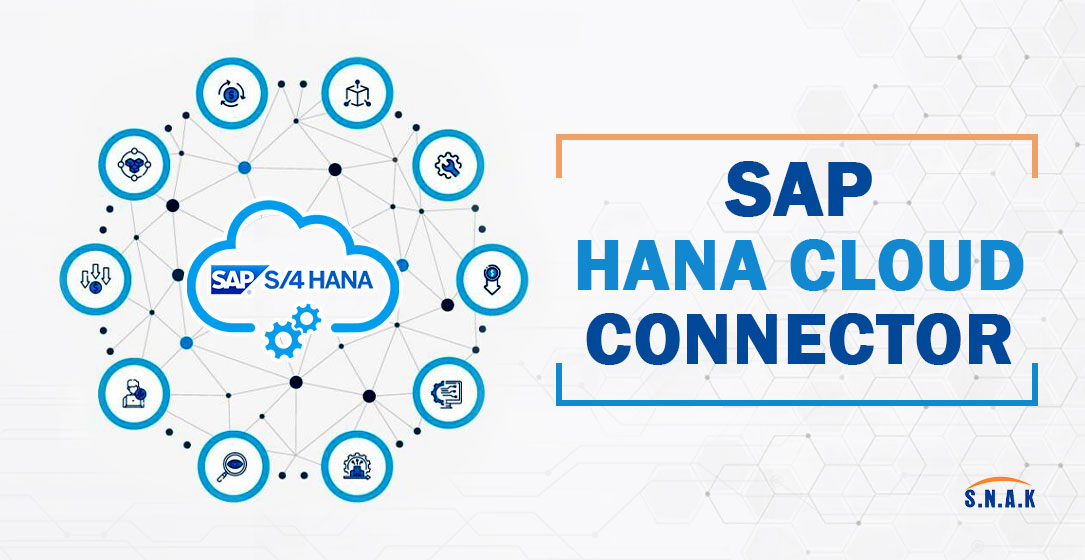July 25, 2023 | SNAK Consultancy
Share on :
SAP HANA Cloud Connector: Seamless Connectivity in the Cloud

In this blog, we will explore how SAP HANA Cloud Connector empowers businesses to achieve smooth integration, enhanced data privacy, and optimal performance.
In today's fast-paced business environment, staying competitive requires harnessing the full potential of cloud technologies while seamlessly integrating them with existing on-premise systems. SAP HANA Cloud Connector (HCC) emerges as a game-changer, providing a secure and efficient way to bridge the gap between cloud and on-premise environments.
Understanding SAP HANA Cloud Connector
SAP HANA Cloud Connector acts as a middleware that facilitates communication between on-premise systems and cloud applications, allowing data exchange in a secure and controlled manner. By acting as a bridge, it extends your corporate network into the cloud, without exposing critical systems to external threats.
Secure Data Exchange
One of the most significant concerns when integrating cloud and on-premise systems is data security. SAP HANA Cloud Connector addresses this by establishing a secure connection that encrypts data during transmission. This ensures that sensitive information remains protected, reducing the risk of unauthorized access and data breaches.
Additionally, the Cloud Connector helps maintain data privacy compliance by limiting direct access to on-premise systems. Instead, it allows you to define specific resources and services to be exposed to the cloud, providing a controlled and secure integration environment.
Seamless Integration
SAP HANA Cloud Connector streamlines the integration process, enabling seamless data exchange between cloud applications and on-premise systems. This real-time synchronization ensures that your data remains up-to-date across both environments, providing a comprehensive and accurate view of your business operations.
The Cloud Connector also offers firewall-friendly connectivity, eliminating the need for complex network configurations. This makes it easier for businesses to integrate cloud applications into their existing infrastructure without compromising security or performance.
Flexibility and Scalability
As businesses grow and evolve, their integration needs change as well. The caters to these dynamic requirements by offering flexibility and scalability. Whether you are a small enterprise or a large corporation, the Cloud Connector adapts to your integration demands, ensuring a smooth and agile experience.
Easy Configuration and Management
Implementing and managing SAP HANA Cloud Connector is a straightforward process. The user-friendly interface allows for quick and hassle-free configuration, reducing the burden on IT teams and freeing up valuable resources for other strategic initiatives.
Moreover, the Cloud Connector provides comprehensive monitoring and logging capabilities, giving administrators insights into the integration performance and identifying potential issues proactively.
Use Cases for SAP HANA Cloud Connector
- Hybrid Cloud Integration: Many organizations operate in a hybrid cloud environment, with a mix of cloud-based and on-premise systems. The serves as the perfect solution to integrate these diverse landscapes, enabling seamless data exchange between both worlds.
- Mobile Access to On-Premise Data: With the Cloud Connector, mobile applications can securely access on-premise data, empowering your workforce with real-time information on the go. This is particularly beneficial for sales teams, technicians, and executives who need access to critical business data on their mobile devices.
- Real-time Data Synchronization: SAP HANA Cloud Connector enables real-time data synchronization between cloud applications and on-premise systems, ensuring that everyone in the organization has access to the most current and accurate data.
Questionnaire
Ques.1 How SAP BTP is different from SAP HANA Cloud?
Ans. SAP BTP (Business Technology Platform) is a comprehensive platform for application development and integration, while SAP HANA Cloud is a cloud-native database and analytics platform focused on processing and analyzing large volumes of data.
Ques.2 What are the features of the SAP Cloud Platform?
Ans. The SAP Cloud Platform offers a range of features, including application development tools, integration services, analytics and business services, database services, security measures, and IoT capabilities. It enables users to build, extend, and integrate applications seamlessly, access data analytics, and ensure high-level security for cloud-based solutions across various industries and business scenarios.
Ques.3 What is SAP Cloud Platform?
Ans. SAP Cloud Platform is an open, integrated platform-as-a-service (PaaS) provided by SAP. It enables businesses to build, deploy, and manage cloud-based applications and services. It offers application development tools, integration services, analytics, and various business services to facilitate digital transformation and innovation in organizations across diverse industries.
Ques.4 What are the main benefits of SAP Cloud Platform?
Ans. The main benefits of SAP Cloud Platform include accelerated application development, seamless integration with SAP and non-SAP systems, access to advanced analytics, robust security features, scalability to accommodate business growth, and the ability to drive innovation and digital transformation by leveraging cutting-edge technologies such as AI, IoT, and machine learning.
Conclusion:
In conclusion, SAP HANA Cloud Connector is a powerful tool that unlocks the true potential of cloud integration while safeguarding the security and privacy of your on-premise systems. Its secure communication, seamless integration capabilities, and user-friendly interface make it an essential component for businesses striving to stay competitive in the digital age.
By embracing SAP HANA Cloud Connector, organizations can enhance their operational efficiency, improve decision-making processes, and elevate the overall user experience. With the power of seamless integration at their disposal, businesses can confidently embark on their journey towards digital transformation and business success.